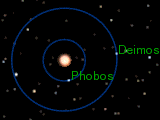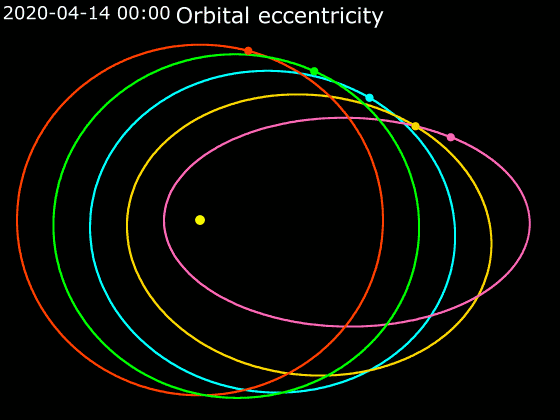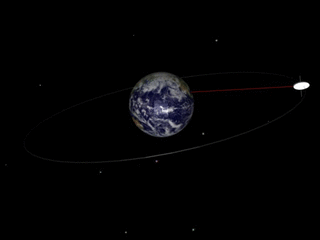|
Supersynchronous Orbit
A supersynchronous orbit is either an orbit with a period greater than that of a synchronous orbit, or just an orbit whose major axis is larger than that of a synchronous orbit. A synchronous orbit has a period equal to the rotational period of the body which contains the barycenter of the orbit. Geocentric supersynchronous orbits One particular supersynchronous orbital regime of significant economic value to Earth commerce is a band of near-circular Geocentric orbits beyond the geosynchronous belt—with perigee altitude above , approximately above synchronous altitude —called the geo graveyard belt. The geo graveyard belt orbital regime is valuable as a storage and disposal location for derelict satellite space debris after their useful economic life is completed as geosynchronous communication satellites. Artificial satellites are left in space because the economic cost of removing the debris would be high, and current public policy does not require nor incentivize ... [...More Info...] [...Related Items...] OR: [Wikipedia] [Google] [Baidu] |
Orbit
In celestial mechanics, an orbit (also known as orbital revolution) is the curved trajectory of an object such as the trajectory of a planet around a star, or of a natural satellite around a planet, or of an artificial satellite around an object or position in space such as a planet, moon, asteroid, or Lagrange point. Normally, orbit refers to a regularly repeating trajectory, although it may also refer to a non-repeating trajectory. To a close approximation, planets and satellites follow elliptic orbits, with the center of mass being orbited at a focal point of the ellipse, as described by Kepler's laws of planetary motion. For most situations, orbital motion is adequately approximated by Newtonian mechanics, which explains gravity as a force obeying an inverse-square law. However, Albert Einstein's general theory of relativity, which accounts for gravity as due to curvature of spacetime, with orbits following geodesics, provides a more accurate calculation and u ... [...More Info...] [...Related Items...] OR: [Wikipedia] [Google] [Baidu] |
Space
Space is a three-dimensional continuum containing positions and directions. In classical physics, physical space is often conceived in three linear dimensions. Modern physicists usually consider it, with time, to be part of a boundless four-dimensional continuum known as '' spacetime''. The concept of space is considered to be of fundamental importance to an understanding of the physical universe. However, disagreement continues between philosophers over whether it is itself an entity, a relationship between entities, or part of a conceptual framework. In the 19th and 20th centuries mathematicians began to examine geometries that are non-Euclidean, in which space is conceived as '' curved'', rather than '' flat'', as in the Euclidean space. According to Albert Einstein's theory of general relativity, space around gravitational fields deviates from Euclidean space. Experimental tests of general relativity have confirmed that non-Euclidean geometries provide a bet ... [...More Info...] [...Related Items...] OR: [Wikipedia] [Google] [Baidu] |
Orbital Injection
In spaceflight an orbit insertion is an orbital maneuver which adjusts a spacecraft’s trajectory, allowing entry into an orbit around a planet, moon, or other celestial body, becoming an artificial satellite. An orbiter is a spacecraft designed for orbital insertion. An orbit insertion maneuver involves either deceleration from a speed in excess of the respective body's escape velocity, or acceleration to it from a lower speed. When the result is a transfer orbit, e.g. a ''descent orbit insertion,'' the maneuver is an orbit injection. Orbit types Orbits are periodic or quasi-periodic trajectories, usually around a central celestial body like the Earth or the Sun. They may also be trajectories around Lagrange point locations in a multi-body system like the Earth–Moon system. (For example, NASA used a halo orbit for the CAPSTONE mission.) Low orbits Low orbits are trajectories deep within the 'gravitational well' of a central body. Examples include low Earth orbit and lo ... [...More Info...] [...Related Items...] OR: [Wikipedia] [Google] [Baidu] |
Apogee Kick Motor
An apogee kick motor (AKM) is a rocket motor that is regularly employed on artificial satellites to provide the final impulse to change the trajectory from the transfer orbit into its final orbit (most commonly circular). For a satellite launched from the Earth, the rocket firing is done at the highest point of the transfer orbit, known as the apogee. An apogee kick motor is used, for example, for satellites launched into a geostationary orbit. As the vast majority of geostationary satellite launches are carried out from spaceports at a significant distance away from Earth's equator, the carrier rocket often only launches the satellite into an orbit with a non-zero inclination approximately equal to the latitude of the launch site. This orbit is commonly known as a "geostationary transfer orbit" or a "geosynchronous transfer orbit". The satellite must then provide thrust to bring forth the needed delta v to reach a geostationary orbit. This is typically done with a fixed onbo ... [...More Info...] [...Related Items...] OR: [Wikipedia] [Google] [Baidu] |
Delta-v Budget
Delta-''v'' (also known as " change in velocity"), symbolized as and pronounced , as used in spacecraft flight dynamics, is a measure of the impulse per unit of spacecraft mass that is needed to perform a maneuver such as launching from or landing on a planet or moon, or an in-space orbital maneuver. It is a scalar that has the units of speed. As used in this context, it is not the same as the physical change in velocity of said spacecraft. A simple example might be the case of a conventional rocket-propelled spacecraft, which achieves thrust by burning fuel. Such a spacecraft's delta-''v'', then, would be the change in velocity that spacecraft can achieve by burning its entire fuel load. Delta-''v'' is produced by reaction engines, such as rocket engines, and is proportional to the thrust per unit mass and the burn time. It is used to determine the mass of propellant required for the given maneuver through the Tsiolkovsky rocket equation. For multiple maneuvers, delt ... [...More Info...] [...Related Items...] OR: [Wikipedia] [Google] [Baidu] |
Geostationary Transfer Orbit
In space mission design, a geostationary transfer orbit (GTO) or geosynchronous transfer orbit is a highly elliptical type of geocentric orbit, usually with a perigee as low as low Earth orbit (LEO) and an apogee as high as geostationary orbit (GEO). Satellites that are destined for geosynchronous orbit (GSO) or GEO are often put into a GTO as an intermediate step for reaching their final orbit. Larson, Wiley J. and James R. Wertz, eds. Space Mission Design and Analysis, 2nd Edition. Published jointly by Microcosm, Inc. (Torrance, CA) and Kluwer Academic Publishers (Dordrecht/Boston/London). 1991. Manufacturers of launch vehicles often advertise the amount of payload the vehicle can put into GTO. Background Geostationary and geosynchronous orbits are very desirable for many communication and Earth observation satellites. However, the delta-v, and therefore financial, cost to send a spacecraft to such orbits is very high due to their high orbital radius. A GTO is an intermedia ... [...More Info...] [...Related Items...] OR: [Wikipedia] [Google] [Baidu] |
Apogee
An apsis (; ) is the farthest or nearest point in the orbit of a planetary body about its primary body. The line of apsides (also called apse line, or major axis of the orbit) is the line connecting the two extreme values. Apsides pertaining to orbits around different bodies have distinct names to differentiate themselves from other apsides. Apsides pertaining to geocentric orbits, orbits around the Earth, are at the farthest point called the ''apogee'', and at the nearest point the ''perigee'', like with orbits of satellites and the Moon around Earth. Apsides pertaining to orbits around the Sun are named ''aphelion'' for the farthest and ''perihelion'' for the nearest point in a heliocentric orbit. Earth's two apsides are the farthest point, ''aphelion'', and the nearest point, ''perihelion'', of its orbit around the host Sun. The terms ''aphelion'' and ''perihelion'' apply in the same way to the orbits of Jupiter and the other planets, the comets, and the asteroids of t ... [...More Info...] [...Related Items...] OR: [Wikipedia] [Google] [Baidu] |
Hohmann Transfer Orbit
In astronautics, the Hohmann transfer orbit () is an orbital maneuver used to transfer a spacecraft between two orbits of different altitudes around a central body. For example, a Hohmann transfer could be used to raise a satellite's orbit from low Earth orbit to geostationary orbit. In the idealized case, the initial and target orbits are both circular orbit, circular and orbital plane, coplanar. The maneuver is accomplished by placing the craft into an elliptical orbit, elliptical transfer orbit that is tangential to both the initial and target orbits. The maneuver uses two impulse (physics), impulsive engine burns: the first establishes the transfer orbit, and the second adjusts the orbit to match the target. The Hohmann maneuver often uses the lowest possible amount of impulse (which consumes a proportional amount of delta-v, and hence propellant) to accomplish the transfer, but requires a relatively longer travel time than higher-impulse transfers. In some cases where one ... [...More Info...] [...Related Items...] OR: [Wikipedia] [Google] [Baidu] |
Elliptic Orbit
In astrodynamics or celestial mechanics, an elliptical orbit or eccentric orbit is an orbit with an eccentricity of less than 1; this includes the special case of a circular orbit, with eccentricity equal to 0. Some orbits have been referred to as "elongated orbits" if the eccentricity is "high" but that is not an explanatory term. For the simple two body problem, all orbits are ellipses. In a gravitational two-body problem, both bodies follow similar elliptical orbits with the same orbital period around their common barycenter. The relative position of one body with respect to the other also follows an elliptic orbit. Examples of elliptic orbits include Hohmann transfer orbits, Molniya orbits, and tundra orbits. Velocity Under standard assumptions, no other forces acting except two spherically symmetrical bodies (m_1) and (m_2), the orbital speed (v\,) of one body traveling along an elliptical orbit can be computed from the vis-viva equation as: :v = \sqrt where: * ... [...More Info...] [...Related Items...] OR: [Wikipedia] [Google] [Baidu] |
Launch Vehicle
A launch vehicle is typically a rocket-powered vehicle designed to carry a payload (a crewed spacecraft or satellites) from Earth's surface or lower atmosphere to outer space. The most common form is the ballistic missile-shaped multistage rocket, but the term is more general and also encompasses vehicles like the Space Shuttle. Most launch vehicles operate from a launch pad, supported by a missile launch control center, launch control center and systems such as vehicle assembly and fueling. Launch vehicles are engineered with advanced aerodynamics and technologies, which contribute to high operating costs. An orbital spaceflight, orbital launch vehicle must lift its payload at least to the boundary of space, approximately and accelerate it to a horizontal velocity of at least . Suborbital spaceflight, Suborbital vehicles launch their payloads to lower velocity or are launched at elevation angles greater than horizontal. Practical orbital launch vehicles use chemical prope ... [...More Info...] [...Related Items...] OR: [Wikipedia] [Google] [Baidu] |
Geosynchronous Orbit
A geosynchronous orbit (sometimes abbreviated GSO) is an Earth-centered orbit with an orbital period that matches Earth's rotation on its axis, 23 hours, 56 minutes, and 4 seconds (one sidereal day). The synchronization of rotation and orbital period means that, for an observer on Earth's surface, an object in geosynchronous orbit returns to exactly the same position in the sky after a period of one sidereal day. Over the course of a day, the object's position in the sky may remain still or trace out a path, typically in a figure-8 form, whose precise characteristics depend on the orbit's inclination and eccentricity. A circular geosynchronous orbit has a constant altitude of . A special case of geosynchronous orbit is the geostationary orbit (often abbreviated ''GEO''), which is a circular geosynchronous orbit in Earth's equatorial plane with both inclination and eccentricity equal to 0. A satellite in a geostationary orbit remains in the same position in the sky to observers ... [...More Info...] [...Related Items...] OR: [Wikipedia] [Google] [Baidu] |
Commsat
A communications satellite is an artificial satellite that relays and amplifies radio telecommunication signals via a transponder; it creates a communication channel between a source transmitter and a receiver at different locations on Earth. Communications satellites are used for television, telephone, radio, internet, and military applications. Many communications satellites are in geostationary orbit above the equator, so that the satellite appears stationary at the same point in the sky; therefore the satellite dish antennas of ground stations can be aimed permanently at that spot and do not have to move to track the satellite. Others form satellite constellations in low Earth orbit, where antennas on the ground have to follow the position of the satellites and switch between satellites frequently. The radio waves used for telecommunications links travel by line of sight and so are obstructed by the curve of the Earth. The purpose of communications satellites is to re ... [...More Info...] [...Related Items...] OR: [Wikipedia] [Google] [Baidu] |






